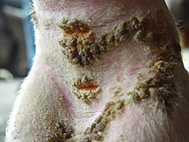Greasy heel (aka mudfever) is a dermatitis-like skin lesion that is usually caused by the same bacteria that results in rainscald, typically affecting the heels and the back of pasterns.
Greasy heel often flares up in wet and humid weather. It is likely to appear on horses with white socks, as they are more likely to become irritated with their increased sensitivity to sunburn, which sometimes develops into greasy heel. Horses that are exercised for extended periods, such as endurance horses, are also more susceptible to this ailment as the sweat running down their legs can irritate and inflame the skin. 
Symptoms of greasy heel can include:
- Affected skin starts off irritated, red, inflamed and/or swollen, developing a weepy discharge that appears ‘greasy’ or sticky. Deep matting and cracks then appear as a result of the dry & inflamed skin being flexed during the horse’s usual movement.
- Swelling of the affected area can also result, with hair loss occurring. Often short tufts of hair are left over the affected area. This irritation can crack and become infected.
- Lameness can result from severe cases of greasy heel as irritation & swelling becomes painful for the sufferer.
We can deal with greasy heel in the following ways:
- Use an antifungal wash, such as Malaseb (the one we usually use). To treat with Malaseb, hose legs then apply malaseb, creating a soapy lather. Leave this lather for 5 to 10 minutes then rinse out well. Use a soft brush or cloth to try and scrape off as much of the lesion (scabbed and matted areas) as possible. Any lesion scabs should be collected and thrown in the bin, and you should wash your hands afterwards (or use gloves) as the fungus can spread to other horses.
- In some cases stronger prescription treatments may be required. Veterinary assistance is very important if the conservative treatment is not improving the condition as this is a very painful condition, in some cases causing lameness.
There are some preventative measures you can put in place to ensure your equine friend doesn’t suffer from this uncomfortable irritation. These can include trying to keep horses away from moist environments as much as possible. These may be wet and muddy paddocks or paddocks with long wet grass. Stables should always be clean and dry. Try applying zinc/sunscreen (approved for equine use) to pastern and coronet areas daily, especially if these areas are white. Also rinsing the horse down adequately after exercise and allowing the legs to fully dry afterwards may also be beneficial.
Greasy heel certainly isn’t fun to deal with, as many Queensland horse enthusiasts are finding they have to fight the battle annually when the wet weather comes. Hopefully with preventative measures in place your horses can avoid this condition, but if you find that they have lesions you will need to opt for treatment. If you find the conservative method is not working please contact us on 5543 1213 for a definitive diagnosis and treatment plan against the painful problems of greasy heel.









